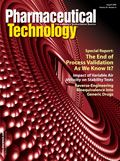I Only Am Escaped Alone to Tell Thee
As one Midwestern city has discovered, there is life after Big Pharma.
I come from going to and fro in the earth, and from walking up and down in it. Oh, and from flying through the dying remnants of hurricanes, too.

Douglas McCormick
It's been a month of visiting plants and labs and people—people who, with the fortitude of Job, struggle to adapt to the profound structural changes transforming our industry. Consolidation is closing plants and eliminating jobs. The harder we swing for R&D home runs, the more we seem to strike out. The drive for process understanding pits finicky processes, regulatory uncertainty, and old habits against the effort to bring manufacturing into the 21st controls Century.
The plane and car time have been worth it: worth the 40-mile detours, the five-hour airport delays, the one-hour flight dilated into three hours with a seat-mate so squirrelly that he sent the flight attendants scurrying to the back of the plane to unpack the restraints. Worth even the very special pat-down from the nice people at the Transportation Security Administration.*
In Cincinnati, we saw a community creatively rebuilding a pharmaceutical tradition half gutted by Big Pharma's consolidation to Route-One-Land, the teeming conurbation stretching from Washington to Boston.
Cincinnati's pharmaceutical industry took its big hit just a few years ago, when Sanofi-Aventis and then Shire Laboratories pulled out and headed east.
The history of the former Marion Laboratories facility here is a 59-acre palimpsest of the industry's evolution. Some plant staff have worked for seven companies without ever leaving the building, receiving paychecks from Marion Laboratories, Marion Merrell Dow, Hoechst, Hoechst Marion Rousell, Aventis, and finally Sanofi-Aventis. When Sanofi-Aventis left for New Jersey, there was talk of turning the site into a mall.
Instead, contract manufacturers Patheon (Missisaugua, Ontario) and Girindus (Bensberg, Germany) moved into the plants, and the University of Cincinnati's Genome Research Institute moved into the laboratories. Patheon makes drug products there, and Girindus (now itself being acquired by Solvay) makes active pharmaceutical ingredients, primarily for scale-up and clinical trials. The Genome Research Institute, despite its name, houses academic and industry scientists studying functional biology and membrane behavior, with a mandate to create ideas that will help build the region's economy.
In short, this single site reflects the industry's arc from small independents, through mergers, internationalization, consolidation and, now, outsourcing. In this age of virtualization, the site offers core pharmaceutical functions from discovery through manufacturing.
Meanwhile, two companies across the Ohio in northern Kentucky complete the picture. Veterans of Shire Laboratories, disenchanted with the firm's relocation plans, founded two new companies within a few months of each other in 2001. Pedia-Med and Xanodyne (the $20-million-a-year pain and obstetric specialists who just bought aaiPharma's assets for $209 million) grew up in the same office suite and are, if not business-model clones, then fraternal twins.
Now, the top ten pharma companies accounted for just over half of the industry's $174-billion in 2004 retail sales, and just under half of the 19,499 approved products listed in the January 2005 FDA Orange Book. But the industry includes another 516 drug makers, including 130 companies producing just one FDA-approved medicine.
That's a lot of activity far from the $100-million-is-too-small-to-bother-with blockbuster mentality of the majors. When pharma's Great Whites feed, significant scraps drift down unnoticed.
And in that niche dwells the virtual specialty pharmaceutical company. There is a certain ecological beauty in the concept: a company of 120 people outsourcing everything but sales. The dozen or so people in the research and development group function as intelligence agents cum financial analysts rather than wet-lab scientists. Manufacturing consists of a couple of folks who manage contracts. At their purest, these virtual companies will identify products with untapped potential, license them in from the current maker, and then contract production back to the original owner.
This isn't a model for the whole industry. It depends too much on Big Pharma's leavings. But it has a pleasingly economical elegance.
And taken together, the region provides an elegant instance of tough, spare New Pharma springing from the empty husks of Old Pharma.
*And I just loved finding that tasteful little "Notice of Baggage Inspection" card, a thoughtful reminder that the state security apparatus has joined trophy-hunting baggage handlers in rummaging through my luggage.
Douglas McCormick is editor in chief of Pharmaceutical Technology, dmccormick@advanstar.com

PacBio Chosen as Tech Partner for Global Alzheimer’s Disease Research Project
April 23rd 2025The project, the North African Dementia Registry, will unite multiple entities for the purpose of developing a comprehensive dataset to advance the research community’s understanding of Alzheimer’s disease and other dementias in diverse populations.
Drug Solutions Podcast: A Closer Look at mRNA in Oncology and Vaccines
April 30th 2024In this episode fo the Drug Solutions Podcast, etherna’s vice-president of Technology and Innovation, Stefaan De Koker, discusses the merits and challenges of using mRNA as the foundation for therapeutics in oncology as well as for vaccines.
Drug Solutions Podcast: Gliding Through the Ins and Outs of the Pharma Supply Chain
November 14th 2023In this episode of the Drug Solutions podcast, Jill Murphy, former editor, speaks with Bourji Mourad, partnership director at ThermoSafe, about the supply chain in the pharmaceutical industry, specifically related to packaging, pharma air freight, and the pressure on suppliers with post-COVID-19 changes on delivery.